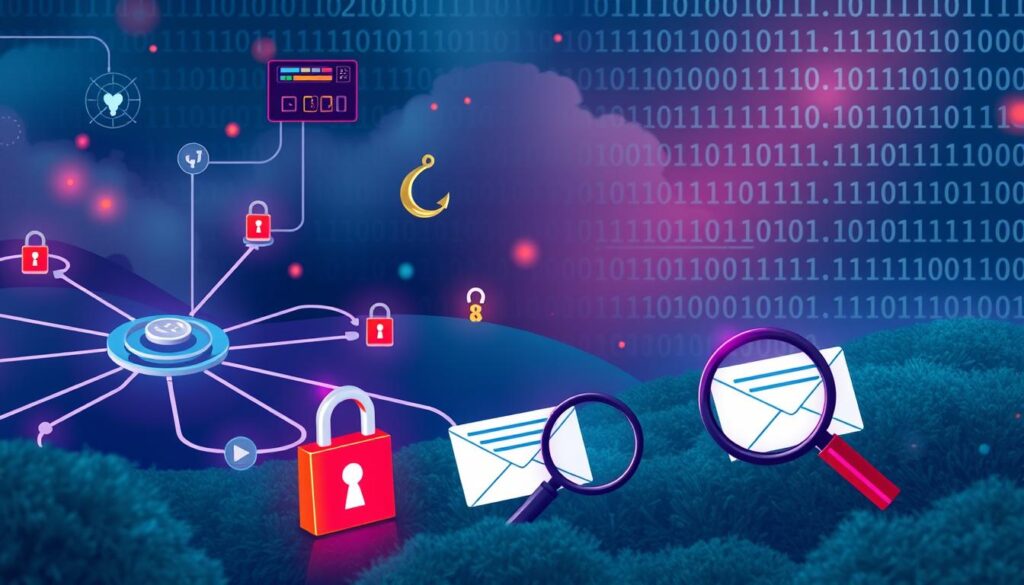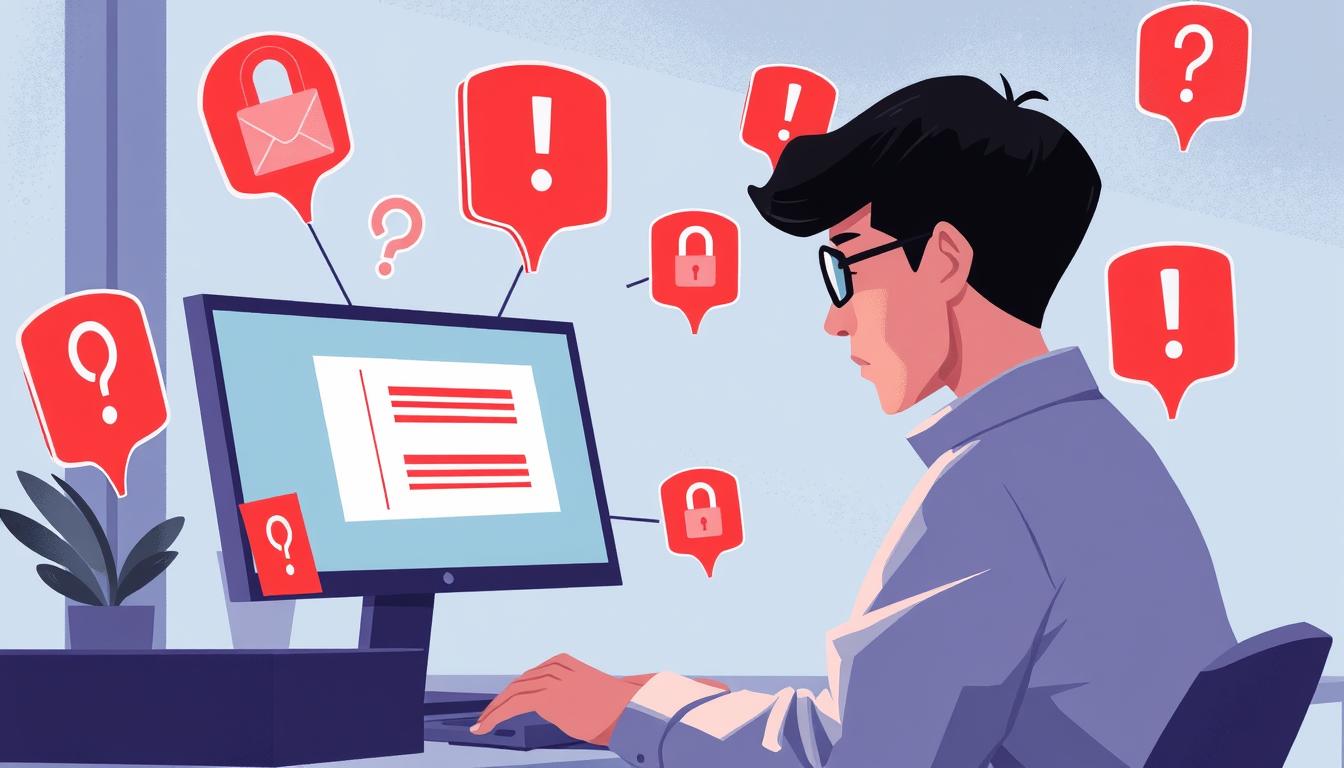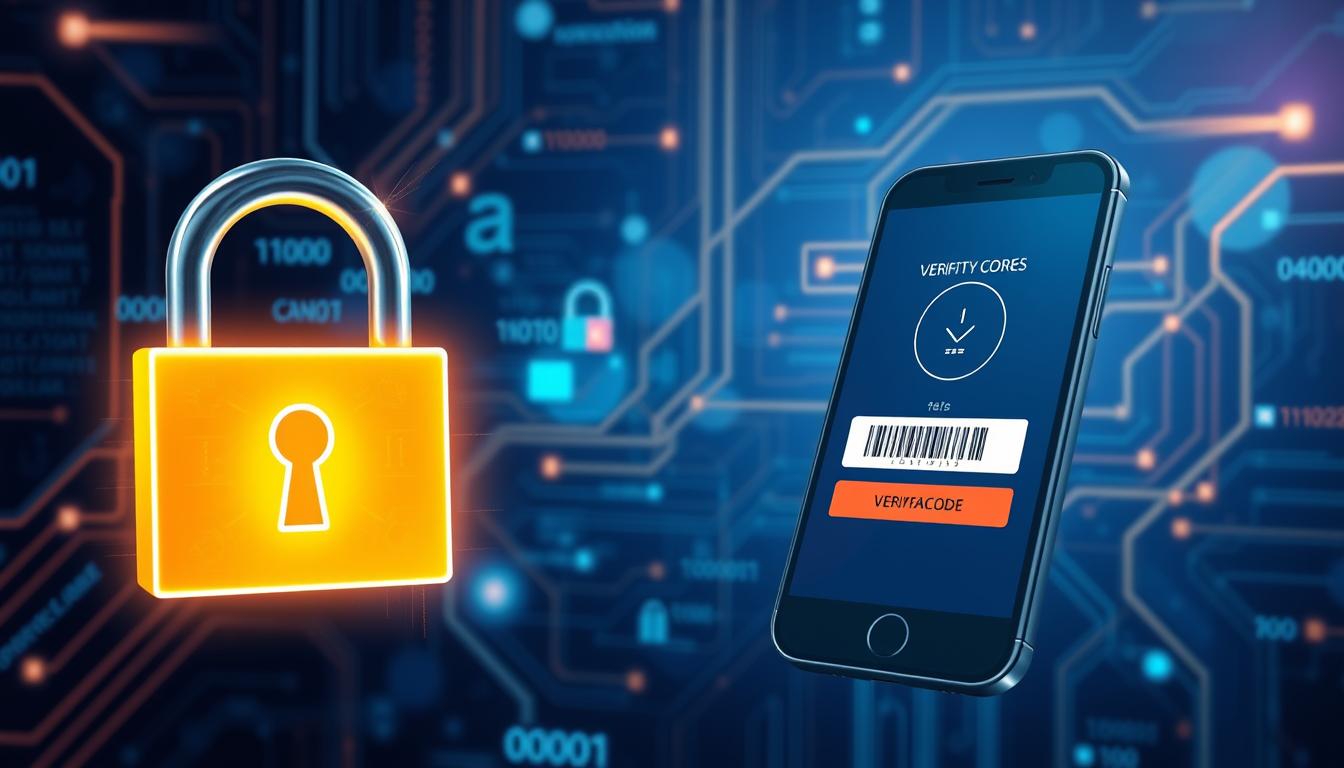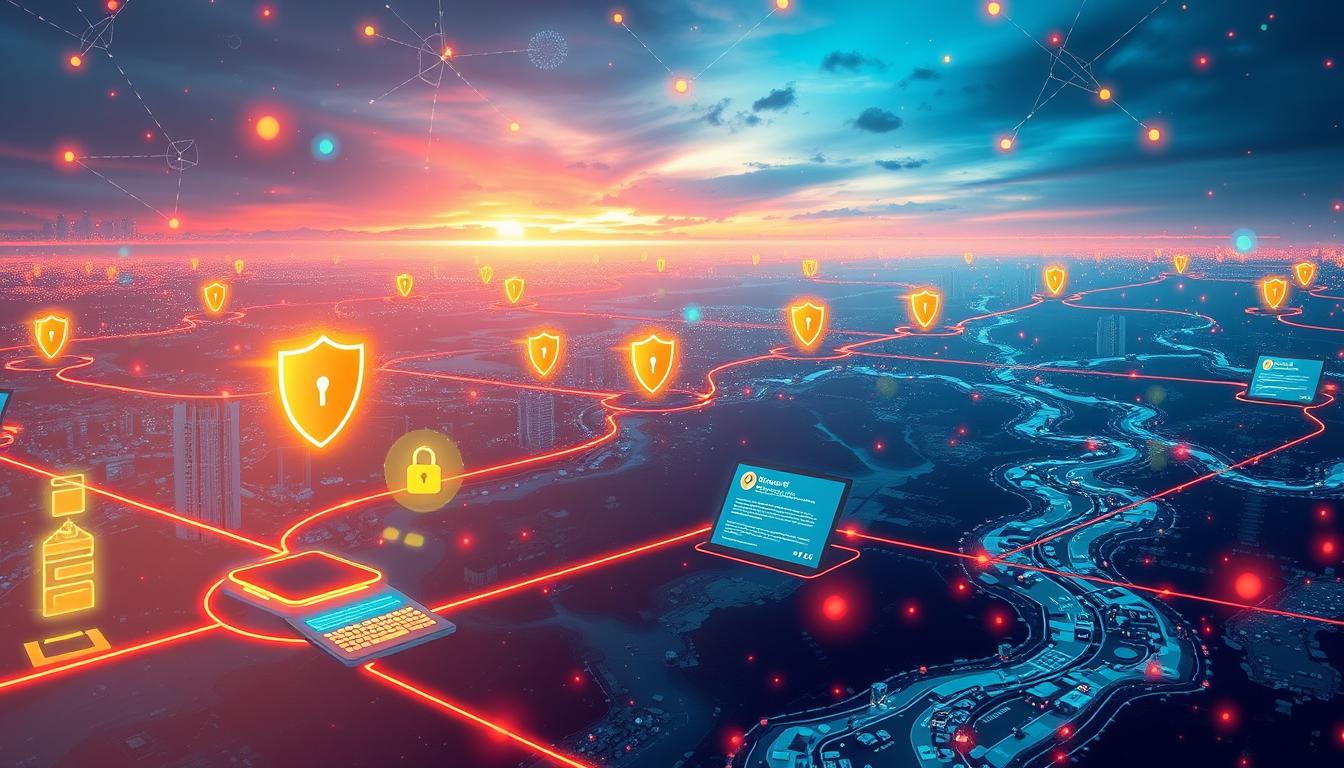Did you know phishing attacks jumped by 25% in the first quarter of 2023? This big increase shows how important it is to stay safe online and know about email scams.
Today, knowing how to avoid phishing scams is crucial. Our Day 6 Cybersecurity Training teaches you to recognize danger signs early. This helps protect your personal and work data from cyber threats.
Phishing attacks can cost companies a lot – about $1.5 million each year1. But there’s good news: training employees can make them 70% less likely to fall for phishing1. This guide will give you the skills to dodge email scams.
Online security is complex, but being careful is essential. With AI-powered phishing emails going up by 60% in a year, it’s vital to stay ahead of scammers1. Let’s explore how to prevent phishing and keep our digital world safe.
Key Takeaways
- Phishing attacks increased by 25% in Q1 2023
- Companies lose $1.5 million annually to phishing incidents
- Phishing awareness training reduces victimization by 70%
- AI-powered phishing emails rose by 60% in the past year
- Multi-Factor Authentication prevents 99.9% of account hacks
- QR code scams surged 300% from 2022 to 2023
Understanding the Growing Threat of Phishing Attacks
Phishing attacks are a big worry in the world of cybercrime. These threats are getting worse, with hackers getting better at tricking people. Let’s look at how phishing is affecting the internet today.
Current Phishing Statistics and Trends
Phishing attempts have gone up a lot in the last few years. In 2022, 83% of UK companies said phishing was their biggest threat, up from 72% in 20172. This problem is not just in the UK, but all over the world. In 2023, there was a 50% jump in phishing scams compared to the year before3.
Phishing is now behind 90% of all data breaches. This shows how important it is to protect against cybercrime3. Sadly, 1 in 4 employees will fall for a phishing test4.
Financial Impact of Phishing Scams
Phishing scams cost a lot of money. Businesses can lose about $1.6 million because of phishing4. Worldwide, phishing scams cost businesses $2.9 million every minute3.
| Phishing Attack Type | Prevalence | Impact |
|---|---|---|
| Email Phishing | 90% of all incidents | Most common entry point |
| Spear Phishing | 30% of attempts | 60% success rate |
| SMS Phishing (Smishing) | 30% year-over-year growth | Rapidly increasing threat |
Evolution of Phishing Techniques
Phishing tactics keep changing. Hackers use big events and fake trusted sources to trick people. For example, emails with huge discounts are often scams2. They also use social media, making up about 20% of phishing attempts3.
To fight these threats, teaching employees is key. About 70% of companies say training is vital in stopping phishing3. This shows how important it is to educate people to stay safe online3.
Avoiding Phishing Scams: Spotting Red Flags Before They Hook You
Phishing scams are a big threat to both personal and business security. They aim to steal sensitive info, leading to data breaches and financial losses. It’s key to know the red flags to avoid these scams and keep your data safe.
Cybercriminals often try to rush you into action in their emails. This makes you more likely to fall for scams5. Watch out for emails that say you must act fast or face bad consequences.
Phishing emails often have bad grammar and spelling. By 2022, most scams had obvious language mistakes5. Check the writing quality in emails, especially if they claim to be from trusted sources.
Key Indicators of Phishing Attempts
- Generic greetings like “Dear Customer” instead of personalized salutations
- Inconsistent links or email addresses not matching the claimed company
- Suspicious attachments, particularly .exe or HTML files
- Offers that seem too good to be true
- Requests for sensitive personal information
Phishing scams cause about 90% of all data breaches, showing how common they are in cybercrime. Sadly, 43% of phishing emails are opened by their targets, and these bad emails are 30 times more likely to be opened than regular ones6.
Strong security measures are vital to avoid data breaches. Using two-factor authentication can stop 99.9% of automated attacks, including phishing scams6. Training employees on cybersecurity can cut the risk of successful phishing attacks by up to 70%6.
“Employees are the first line of defense against phishing scams, highlighting the importance of cybersecurity education.”
To better protect against phishing, businesses should use email filters, enforce strong passwords, and use email authentication. Keeping software up to date and watching network traffic closely are also key to catching and stopping phishing attempts7.
| Phishing Type | Description | Key Characteristics |
|---|---|---|
| Email Phishing | Most common form | Urgent requests, suspicious links |
| Spear Phishing | Targeted attacks | Personalized approach, higher success rate |
| Vishing (Voice Phishing) | Phone-based scams | Impersonation of legitimate representatives |
| Smishing (SMS Phishing) | Text message scams | Urgent claims from trusted sources |
By being alert and knowing these red flags, both individuals and organizations can greatly reduce their chances of falling for phishing scams. This helps keep their data safe and their malware protection strong.
Common Types of Phishing Attacks in 2024
Staying informed about phishing attacks is key to protecting our digital security. In 2024, email is the main way scammers attack, with over 90% of incidents reported8. Let’s look at the most common phishing attacks.
Email Phishing Campaigns
Email phishing is a big worry, with scammers sending thousands of attacks every day8. They often target banks and financial sites, making up 25% of phishing attempts8. Scammers use AI to make their emails seem real, making them tricky to spot.
Spear Phishing Tactics
Spear phishing is when scammers target specific people or groups. They might pretend to be bosses to seem more believable9. These attacks are clever, using fake emails that seem real but have small differences9.
Smishing and Vishing Attacks
Smishing and vishing are becoming more common, using phones and texts. They try to scare people into acting fast9. Learning about digital safety is important to fight these threats.
QR Code Phishing (Quishing)
QR code phishing, or “quishing,” is a new threat. It uses QR codes and tries to build trust over time9. Being careful and staying informed is the best defense.
“The average cost of a successful phishing attack on a business can exceed $1.6 million when including data theft, recovery, and lost productivity.”
To protect ourselves, using extra security steps can block almost all attacks8. It’s also important to learn about phishing regularly, ideally every few months9.
Essential Red Flags in Suspicious Emails
Phishing attacks have skyrocketed, with a staggering 600% increase in the past year10. Spotting red flags is now more important than ever for online security. Cybercriminals use email fraud to trick victims, often creating a false sense of urgency.
Pressure tactics are a common phishing trick. Over 50% of phishing emails try to scare or rush you into action10. They might say “Your account will be locked in 24 hours!” to panic you.
Deceptive sender addresses are another red flag. Emails from senders that look almost like real companies but have small mistakes are common11. Always check the sender’s email address for any oddities.
Grammar and spelling mistakes in emails are also warning signs. Legit companies usually proofread well, so many errors mean trouble.
| Red Flag | Description | Prevalence |
|---|---|---|
| Urgency Tactics | Creating false time pressure | 60% of attacks11 |
| Deceptive Links | Misleading URLs in emails | 70% of attempts10 |
| AI-Generated Content | Sophisticated, persuasive text | 97% more effective10 |
It’s crucial to recognize these red flags, as 1 in 99 emails is a phishing attempt10. By being alert and learning about phishing, you can greatly improve your online security. This helps keep your sensitive information safe from cybercriminals.
Social Engineering Tactics Used by Cybercriminals
Cybercriminals use human psychology to get past security. Social engineering is key in many phishing attacks. It’s a big threat to our online safety and identity.
Psychological Manipulation Techniques
Cybercriminals play on our trust, fear, curiosity, and urgency. These tactics work well, with 95% of cyberattacks using social engineering. Also, 60% of phishing emails are opened by victims12.
Phishing scams cause 36% of data breaches. This shows we need better ways to fight cybercrime12.
Urgency and Fear-Based Tactics
Attackers use urgency or fear to make victims act fast. This plays on our natural quick reactions to threats. Research shows 32% of employees click on phishing links12.
Authority Impersonation Methods
Cybercriminals pretend to be trusted figures or organizations. For example, 80% of international students were targeted by scammers pretending to be U.S. government agencies13. Whaling attacks, targeting high-level executives, increased by 15% in 202212.
“Phishing scams, even poorly-worded ones, can be a lot more targeted and convincing when they’re coming directly from a platform’s mobile app.” – Brian Krebs
Knowing these tactics is key to staying safe online. Training employees can lower phishing attack success by up to 70%. This shows how important prevention is in keeping organizations secure12. By staying alert and informed, we can protect ourselves and our organizations from these threats.
Advanced Phishing Detection Strategies
In today’s digital world, fighting phishing is a big challenge. 80% of businesses worldwide face phishing attacks as their main security issue14. It’s more important than ever to have strong detection methods.
Phishing attacks are a big problem, with 91% coming from emails. Companies lose an average of $3.86 million per breach1415. To fight back, companies are using new technologies and being proactive.

Artificial intelligence and machine learning are changing how we detect phishing. These tools can look at lots of data quickly, finding things humans might miss. AI can block up to 99% of phishing emails before they get to your inbox15.
Keeping an eye on things and using real-time threat info is key. Regular security updates can cut phishing risks by up to 40%14. It’s important, as it takes 206 days on average to spot a phishing attack16.
Teaching employees is also crucial. Companies that train regularly see a 50% drop in phishing success14. Regular phishing tests can lower risks by 70%15.
“Amateurs hack systems, professionals hack people.” – Bruce Schneier, Cybersecurity Expert
Looking ahead, new threats like quantum computers are coming. They could break current encryption in the next 10 years15. By using these advanced methods, we can improve our online safety and stay ahead of phishing.
Protecting Sensitive Information Online
In today’s digital world, keeping your data safe is key. Phishing attacks, which make up about 90% of cyber attacks, are a big threat17. We’ll look at ways to keep your online info secure and fight off malware.
Password Security Best Practices
Strong passwords are your first defense. Make each password unique and complex. Using a password manager can also help, especially since phishing attacks have a 20% success rate17.
Multi-Factor Authentication Implementation
Multi-factor authentication adds an extra layer of security. It requires more than one form of verification, making it harder for hackers to get into your accounts. This is important because 1 in 4 people will click on a phishing link if it looks like it’s from someone they trust16.
Data Encryption Methods
Encryption is key to keeping your data safe. It makes your information unreadable to anyone who shouldn’t see it. This is crucial since 70% of phishing emails have malicious links17.
By using these security steps, you can greatly reduce the risk of data breaches. Remember, training users can cut phishing attack success by up to 85%17. Always be careful and think before you click to keep your online space safe.
| Security Measure | Effectiveness |
|---|---|
| Strong Passwords | Reduces risk of account compromise |
| Multi-Factor Authentication | Adds extra layer of security |
| Data Encryption | Protects sensitive information |
| User Training | Lowers phishing attack success rate |
Take charge of your online security today. The cost of a successful phishing attack on a company can be over $1.6 million1716. Don’t let yourself become a victim. Make protecting your data a priority and stay safe online.
Modern Phishing Prevention Tools and Technologies
Today, fighting phishing threats is key. Last year, over 500 million phishing attacks were reported18. To keep up, companies are using the latest technologies.
Advanced email filters are a strong defense. They use AI to check messages and block suspicious ones. Browser extensions also help, analyzing threats as you browse.
AI is changing how we fight malware. It spots complex phishing attacks that old methods miss. Companies using anti-phishing software see a 70% drop in successful attacks18.
Keeping software up to date is critical. Cybercriminals keep finding new ways to attack. Using multi-factor authentication can cut account breaches by 99.9%18.
Choosing the right tools is important for stopping email fraud. Small businesses need affordable, effective solutions. Free resources from CISA can help with training without extra costs19.
Using these modern tools can greatly improve defense against phishing. With the right tech and training, the risk of falling for scams can drop by 50%18.
Corporate Email Security Protocols
In today’s digital world, strong email security is crucial. Companies must use effective strategies to fight phishing and data breaches.
Email Filtering Systems
Advanced email filters are a key defense against data breaches. They catch and block up to 99% of spam and phishing emails20. This helps keep employees safe from scams.
Security Awareness Programs
Good security training is vital for employee safety. Companies that train regularly can cut phishing incidents by up to 70%20. Training teaches staff to spot and report threats, making everyone more alert.
Training should include:
- Learning to spot phishing scams
- Safe email habits
- Keeping passwords secure
- The value of two-factor authentication
Incident Response Procedures
Having clear plans for when a phishing attack is found is key. Companies should have detailed steps for reporting and dealing with suspicious emails. This helps stop threats fast and prevents data breaches.
| Security Measure | Impact |
|---|---|
| Email Filtering | Blocks 99% of spam and phishing emails |
| Security Training | Reduces phishing incidents by 70% |
| Two-Factor Authentication | Prevents 99.9% of automated attacks |
By using these measures, companies can greatly improve their fight against cybercrime. With 74% of companies seeing email as a major cyber threat, strong email security is more important than ever20. Creating a culture of digital safety and awareness is essential for protecting data and keeping businesses running smoothly.
Mobile Device Phishing Protection
Smartphones are now key parts of our lives, making mobile phishing protection vital for staying safe online. The number of mobile phishing attacks has jumped by 85% in the last year. This shows we need better cybersecurity fast21.
Smishing and bad apps are big problems. Scammers use fake emails that look real to trick us into giving out personal info22. It’s important to watch out for these tricks.
- Install and regularly update mobile antivirus software
- Be cautious when downloading apps, checking permissions carefully
- Use strong, unique passwords and change them regularly23
- Enable two-factor authentication for added security23
Phishers often pretend to be from Amazon or Microsoft, making up 80% of attacks22. Be careful of emails or messages from these companies.
Never click on suspicious links or provide personal information in response to unsolicited messages.
By following these tips, you can lower your risk of falling for mobile phishing. Stay alert, stay safe, and keep your mobile devices secure in today’s world.
| Phishing Risk Factor | Percentage |
|---|---|
| Users unable to identify phishing attempts | 33%21 |
| Data breaches involving phishing | 36%21 |
| Organizations experiencing phishing attacks in 2023 | 82%21 |
Best Practices for Reporting Suspicious Activities
Reporting suspicious activities is key to stopping cybercrime. Phishing scams are behind over 90% of cyberattacks. It’s important to have clear ways to spot and report threats24.
Internal Reporting Procedures
Companies should make it easy for employees to report odd emails or activities. A “see something, say something” mindset helps a lot. Training employees can cut phishing success by up to 70%, showing how important digital skills are24.
External Resource Coordination
Working with outside groups like cybersecurity firms or police is key for serious threats. This teamwork boosts our fight against cybercrime. Remember, most fraud complaints start with a phone call, so we need good reporting systems25.
Documentation Requirements
Keeping detailed records of suspicious activities is crucial. Here’s what you need to document:
| Requirement | Description |
|---|---|
| Date and Time | Record when the suspicious activity occurred |
| Nature of Activity | Describe the type of suspicious behavior or content |
| Affected Systems | Identify which devices or networks were involved |
| Actions Taken | Document immediate responses and mitigation steps |
| Reporting Person | Include contact information of the individual who reported the incident |
By following these steps, we can all help fight cybercrime better. Since COVID-19, cybercrime has jumped by 400%. So, reporting suspicious activities is more important than ever26.
Conclusion
Avoiding phishing scams is key in today’s digital world. Over 300,000 people reported phishing attacks to the FBI in 202227. Cybersecurity awareness is crucial, as 91% of cyberattacks start with phishing emails28.
Identity theft is a big risk for phishing victims. They are three times more likely to face identity theft within a year28. Using two-factor authentication can greatly reduce risks, but only half of people use antivirus software28.
SMiShing, a type of phishing through text messages, is becoming more common. Cybercriminals use fake numbers and urgent messages to trick people29. To stay safe, watch out for suspicious texts and report them to 7726 (SPAM) for carrier review29. Staying informed and alert is your best defense against phishing scams.
FAQ
What are the most common red flags in phishing emails?
Look out for urgent requests for personal info, odd sender addresses, and spelling mistakes. Be cautious of emails that try to scare you into acting fast.
How can I protect my mobile device from phishing attacks?
Use a strong mobile device management (MDM) solution and antivirus software. Be careful with app permissions and links in texts. Keep your device and apps updated to stay safe.
What is spear phishing, and how does it differ from regular phishing?
Spear phishing targets specific people or groups. It’s more personal than regular phishing, making it harder to spot.
How can I implement strong password security practices?
Create unique, complex passwords for each account. Use a password manager and enable multi-factor authentication. Update your passwords often and avoid easy-to-guess info.
What should I do if I suspect I’ve fallen victim to a phishing attack?
Change your passwords right away if you think you’ve been phished. Tell your IT team if it’s work-related. Watch your accounts for odd activity and report the issue.
What is QR code phishing or “quishing”?
QR code phishing uses fake QR codes to trick people into visiting fake sites or downloading malware. Always check the URL before scanning QR codes from unknown sources.
How can organizations improve their email security protocols?
Use advanced email filters and train employees on security. Have clear response plans and keep systems updated. Use DMARC, SPF, and DKIM to stop email spoofing.
What role does artificial intelligence play in phishing detection?
AI helps detect phishing by analyzing patterns and content in real-time. It catches threats that traditional methods might miss.
How can I report a suspected phishing attempt?
Send the suspicious email to your IT team or to places like the Anti-Phishing Working Group (reportphishing@apwg.org) or the FBI’s IC3. Keep the original email for investigation.
What are some effective strategies for educating employees about phishing risks?
Hold regular training sessions and simulate phishing attacks. Teach employees how to spot and report suspicious emails. Keep them updated on new phishing tactics.
Source Links
- Phishing Email 101: Red Flags Every Employee Should Know – https://www.linkedin.com/pulse/phishing-email-101-red-flags-every-employee-should-know-one2one-inc-s5e9e
- Off the hook: 6 Tips to avoid Phishing scams – https://www.axians.co.uk/news/avoidphishing/
- Phishing Scams & Attacks – How to Protect Yourself – https://www.kaspersky.com/resource-center/preemptive-safety/phishing-prevention-tips
- Phishing Email 101: Protect Your Business | Mailchimp – https://mailchimp.com/resources/phishing-email/
- 7 Red Flags to Alert You to a Potential Phishing Scam – https://eits.uga.edu/stories/sevenwaystoidentifyaphishingscam/
- How To Avoid Phishing? | IOTEC Digital – https://iotecdigital.com/blog/how-to-avoid-phishing/
- Don’t Get Hooked: How to Avoid Phishing Scams — Lockstock Cybersecurity and Analytics – https://www.lockstockcyber.com/blogs/dont-get-hooked-how-to-avoid-phishing-scams
- How To Recognize and Avoid Phishing Scams – https://consumer.ftc.gov/articles/how-recognize-and-avoid-phishing-scams
- How to Prevent Phishing – The LastPass Blog – https://blog.lastpass.com/posts/how-to-prevent-phishing
- Phishing Email 101: Red Flags Every Employee Should Know – https://www.one2oneinc.com/news/phishing-email-101-red-flags-every-employee-should-know/
- How to spot a phishing email, and how to prevent them – Twister Solutions – https://twistersolutions.com/how-to-spot-a-phishing-email-and-hot-to-prevent-them/
- What is Social Engineering? – https://www.paloaltonetworks.com/cyberpedia/what-is-social-engineering
- Phishing and Scams | Kent State University – https://www.kent.edu/secureit/phishing-and-scams
- 4 Steps to Prevent Phishing Attacks (According to 33 Experts) – https://www.digitalguardian.com/blog/phishing-attack-prevention-how-identify-prevent-phishing-attacks
- A Deep Dive into Phishing: How to Avoid Email Scams – https://substack.com/home/post/p-144722944?utm_campaign=post&utm_medium=web
- Protect Yourself and Others – Phishing – https://kb.ndsu.edu/it/page.php?id=97396
- Phishing Email Examples: Spotting the Hook in the Inbox – Social Security – https://socialsecurity.gov.mt/en/phishing-email-examples-spotting-the-hook-in-the-inbox/
- How to Spot an Email Phishing Attempt at Work – https://www.identityiq.com/articles/how-to-spot-an-email-phishing-attempt-at-work
- Teach Employees to Avoid Phishing | CISA – https://www.cisa.gov/secure-our-world/teach-employees-avoid-phishing
- Cloaked – Dodging the Digital Deceit: How to Avoid Phishing and Other Scams – https://www.cloaked.com/post/dodging-the-digital-deceit-how-to-avoid-phishing-and-other-scams
- BANK IOWA DON’T TAKE THE BAIT – https://www.bankiowa.bank/about-us/front-porch-blog/dont-take-the-bait-how-to-avoid-a-phishing-scam
- Avoid Getting Hooked by Phishing – https://www.technology.pitt.edu/blog/avoid-getting-hooked-phishing
- How To Identify A Phishing Message On Meta | January Spring – https://januaryspring.com/2024/08/14/spotting-the-red-flags-how-to-identify-a-phishing-message-on-meta/
- Phishing Scams: How to Recognize and Avoid Them – Infinet – https://www.omahait.com/how-to-recognize-and-avoid-phishing-scams/
- Protect Yourself from Scams – First National Bank in Philip – https://www.fnbphilip.com/protect-yourself-from-scams/
- 10 Cybersecurity Tips | Blog – https://www.academybank.com/article/10-tips-for-cybersecurity
- How to Spot Phishing Emails and Scams | McAfee Blog – https://www.mcafee.com/blogs/privacy-identity-protection/plenty-of-phish-in-the-sea-your-guide-to-spotting-phishing-emails-and-scams/
- What is phishing? How to spot and avoid it – https://us.norton.com/blog/online-scams/what-is-phishing
- SMiShing: Beware of Text Message Scams – https://portage.life/article/smishing-beware-of-text-message-scams/










